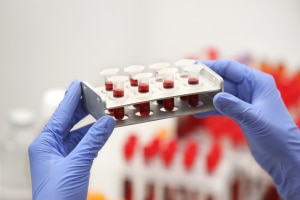New Products Kept Coming in 2018
In this article, we take a look back at the second half of a busy 2018. BioInformatics Inc. is know by many for our report catalog, but we’re also very proud of our ability to deliver Voice of Customer research to our clients’ New Product Development (NPD) initiatives. To stay on top of market developments our market analysts and the intrepid reporters of Instrument Business Outlook routinely travel to major scientific conferences and report on the most significant product releases they’ve seen. Here’s a little of what we observed in the second half of the year…

Scientist working with blood samples at laboratory
In July we traveled to Belgium for the first European Conference & Exhibition hosted by The Society for Lab Automation and Screening (SLAS). While we were there Dispendix introduced its prototype Calibri, an instrument designed to evaluate the accuracy of other liquid dispensing systems. Dispendix has developed unique droplet forming technology, which ensures a consistent size for use in its own dispensing solutions. The Calibri uses this same technology to gauge the accuracy of other liquid handling systems.
Bruker had a “Bruker-ized” version of the system acquired just a month earlier from Sierra Sensors. Bruker expects the new system to be highly complementary with its MALDI MS systems for conducting binding assays after primary screening has been accomplished.
We were also interested to see Cytosmart has continued to develop its OMNI brand of live cell imaging, and its newest version expands the product from a single imaging area to a large-format imager that can analyze entire incubator bottles.
A relatively new market entrant, Yamaha Motor has created life science robotics solutions. The new business venture began in September 2017, and the Cell Handler is the first product developed. The system, which began shipping last year, performs colony/cell picking and digital imaging.
At the end of July, we saw Waters acquired exclusive rights to DESI (desorption electrospray ionization) technology from Prosolia and the Purdue Research Foundation (PRF). “DESI mass spectrometry imaging provides complementary and actionable data when compared to classical histopathology imaging technologies with major advantages in analyzing the molecular fingerprint within a sample, thus delivering deeper biological insights,” stated Waters Chairman and CEO Chris O’Connell.

Scientist working with blood samples at laboratory
Next up was a trip to Chicago for the American Association of Clinical Chemistry (AACC) annual meeting in August. This conference is always one of the most interesting events we attend all year.
While we were there, Fujirebio Diagnostics announced that it received FDA clearance for the company’s Lumipulse G B•R•A•H•M•S PCT Assay for testing on its LUMIPULSE G1200. This was a significant event because the Lumipulse G B•R•A•H•M•S PCT Assay aids in clinical decision-making as it pertains to antibiotic treatment decisions for patients with suspected or confirmed sepsis and also lower–respiratory tract infections.
SCIEX Diagnostics unveiled its Topaz Prep Station, an automated workstation for labs regularly processing a high volume of samples. The new sample preparation workstation works with the Topaz LC-MS/MS System, which designed to be easy enough to operate for those new to mass spec.
On the other side of the exhibit hall, Sysmex celebrated 50 years serving labs with products and solutions in hematology, urinalysis and flow cytometry. Sysmex showcased its ability to provide personalized, convenient lab education through the VIRT (Virtual Instructor-Led Training) training, which is offered as a free and unlimited educational resource. Designed for labs, students are trained by Sysmex’s technical professionals through streaming HD instructional videos on lab technology and workflows.
Porex is an interesting supplier of porous polymers used across a variety of areas in clinical sciences, including sample prep for IVD, molecular and clinical diagnostics, liquid handling and microfluidic applications. At AACC, they unveiled their Collection to Detection solutions. The company discussed detailed the importance of sample integrity and knowing if a sample is contaminated on the front end, before analysis. When a sample is found contaminated after it is tested, it can damage a lab’s operation, and if enough contaminated samples are discovered, a lab’s credibility
Our colleagues from Instrument Business Outlook got to sit in on a press conference with Roche Diagnostics CEO Ron Diggelmann, Jack Phillips, the president and CEO of Roche Diagnostics North America, and Justin Bruek of NorthShore University Health System spoke in depth about health care information management. Throughout the briefing, Roche cited several acquisitions and partnerships, conveying that collaboration is an integral part of their strategy for the future. The acquisitions and partnerships were depicted as part of a continuum involving multiple variables: research, laboratory, clinical settings and payers.
The company’s recent acquisitions of Foundation Medicine, Flatiron Health, Viewics and Navify, as well as its partnership with GE Healthcare were noteworthy mentions throughout the briefing.
The summer closed out with Bio-Techne introduced a new range of Tocris Bioscience-branded stem cell research compounds, which are suitable for use as ancillary materials in the development of stem cell therapies. Around the same time, 10x Genomics made its first acquisition by buying Epinomics for an undisclosed amount. 10x Genomics plans to integrate Epinomics’ technology into its Chromium Single Cell ATAC Solution which launched in October.
In September we noted that QIAGEN planned to merge with molecular diagnostics firm NeuMoDx by acquiring the 80% of the company it did not already own. Thierry Bernard, senior vice president of Molecular Diagnostics at QIAGEN, told IBO, “With the addition of NeuMoDx to its Sample to Insight portfolio, QIAGEN is now the only company that can address the needs of any lab worldwide with highly complementary automation systems, ranging from low-plex to high-plex, from low throughput to high throughput, and covering the most important technologies with PCR [and] NGS.”
Also in September, Agilent Technologies entered the flow cytometry market by acquiring has agreed to acquire ACEA Biosciences for $250 million in cash. ACEA Biosciences supplies the NovoCyte benchtop flow cytometer, including a clinical system, as well as the xCELLigence instruments for monitoring of cell growth, cell function, and cellular responses. The acquisition contributes to Agilent’s goals to expand its cell analysis business and its clinical business in China. In China, ACEA Biosciences sells a China FDA-approved clinical flow cytometer system, which will now use flow cytometer reagents from Agilent’s (formerly Dako’s) Reagent Partnership business.

Pacific Biosciences announced a major leap for its SMRT sequencing technology. The company launched v6.0 software and v3.0 reagents for its Sequel long-read sequencing system. The product updates increase read length from up to 30 kb for gDNA and up to 100 kb for amplicons. The new enhancements are also a major development in that they increase single-molecule read accuracy to over 99%, on par with Illumina’s short-read sequencing and Sanger sequencing.
Pacific Biosciences told IBO that SMRT sequencing will be able to compete directly with Illumina on price per whole genome as the company will next year release the 8M SMRT Cell, with eight times higher throughput. Dr. Korlach said that it will now be more cost effective for researchers to use Pacific Biosciences on all sample types as opposed to just high-value samples. The use of SMRT technology will allow access to structural variation at a price comparative to Illumina’s for whole genomes. Other applications include studying rare diseases to further increase solve rates, and de novo assembly of population-specific reference genomes.
Other NGS product launches at the show included Roche’s AVENIO Tumor Tissue Analysis Kits for research, consisting of the AVENIO Tumor Tissue Targeted Kit, Expanded Kit and Surveillance Kit. The Kits enable a single workflow for measurement of SNVs, indels, fusions and CNVs. This follow last year’s introduction of the AVENIO ctDNA Targeted Kit liquid biopsy, providing a tissue equivalent to that kit. According to the company, it is the only supplier with such panels for both liquid biopsy and tissue analyses, enabling testing for similar results.
Among the products Agilent Technologies promoted at its booth was the Agilent XT HS and XT Low Input Enzymatic Fragmentation Kit. The Kit enables fragmentation of 10–200 ng of DNA. As Kamni Vijay, Vice President and General Manager, Agilent Genomics Division told IBO, the Kit is another example of Agilent providing its NGS cutomers with a full range of options for their workflows.
Mission Bio and NanoCellect were among the companies exhibiting products introduced within the last year. MissionBio’s Trapestri system is a cell capture solution for targeted single-cell analysis using DNA. Up to twenty thousand cells can be analyzed at a time, resulting in a decreased cost compared to lower-capture techniques, such as FACS, according to the company. Applications include QC of CRISPR/Cas9 techniques. Addressing the need for low-cost cell sorting solutions, NanoCellect exhibited the WOLF Cell Sorter. Disposable chips guarantee a sterilized solution with 3-color, 5-parameter sorting at 300 cells per second.
The biggest news in November was Illumina’s announcement of its intent to acquire Pacific Biosciences. The acquisition will bring together the largest short-read and largest long-read sequencing companies, respectively, bridging a divide that has characterized the post-Sanger sequencing market since its inception. As Illumina stated in its conference call discussing the deal, being able to offer its customers both technologies will be a competitive advantage. “Over time, we will provide more seamless integration of the workflows and analytical pipelines to allow customers easier access to the combined power of the two technologies,” stated President and CEO Francis deSouza. “We expect that together these benefits will allow broader market access, enabling faster growth. Together, we will provide more researchers, more physicians, more patients and more consumers a more perfect view of a genome.”

Bruker launched two new systems at the show. A result of its purchase of Luxendo Bioscience, the new Luxendo MuVi SPIM CS light-sheet fluorescence microscope expands the Luxendo MuVi SPIM product line with the ability to image clear tissues in 3D. A modular system, the same instrument can be used to image living samples and cleared tissue samples. Bruker’s new Ultima 2Pplus wide-field, multiphoton microscope replaces the Ultima 2P – capable of 1-photon imaging of up to 500 µm depths and 2-photon imaging down to 1 mm, the system is also future-proofed for 3-photon imaging.
Also, with a focus on accommodating larger animal models, such as mice and hamsters, Leica Microsystems displayed the SP8 DIVEB (Deep In Vivo Explorer) for multicolor, multiphoton imaging, a new iteration of the SP8 DIVE system featuring a larger sample chamber. The new systems enable behavioral studies. Leica Microsystem’s product launches also included the Thunder imagers for wide field imaging, specifically designed for improved resolution of thick specimens. The platform works by removing autofocus light so that only the desired signal is acquired. Applications include 3D cell culture and 3D live cells, tissues and model organisms.
Although companies known for general lab equipment were not as prevalent at the show, Eppendorf and Sartorius each exhibited. Eppendorf displayed its new CellXpert C170i CO2 incubator. The system, along with the more basic C170 model, is the company’s first new incubator since the Galaxy CO2 incubators from New Brunswick Scientific, which Eppendorf acquired in 2007. Bio-Techne was also there, displaying Jess, its latest automated Western blot system which expands beyond chemiluminescence detection to include NIR and IR detection, keeping high sensitivity for multichannel, multiplexed analyses. Multiple detection modes can replace the use of two instruments as well as serve users in the same lab with different requirements.


As a result of our acquisition of IMV, the market research leader in medical imaging, we closed out the year at the Radiological Society of North America’s annual meeting in snowy Chicago. While there, we met with many of our diagnostic imaging clients and learned a great deal about how radiology is embracing artificial intelligence. The rise of digital imaging, along with the lack of interoperability of systems, the shortage of radiologists, and physician burnout, in recent years has contributed to an increase in demand for value-based imaging, according to Dr. Vijay Rao, who is the David C. Levin professor and chairwoman of radiology at Thomas Jefferson University and hospitals. AI and machine learning have emerged as a means of meeting this demand – potentially enabling radiologists and other clinicians to harness the large amount of complex imaging data available even more effectively. With the help of AI, radiologists can rebrand reading rooms as diagnostic data hubs (as they once were in the past) in which various clinicians can make patient management decisions collectively through virtual conferencing. Radiologists could also use AI to aggregate imaging findings with other relevant information such as biopsy findings, lab results, and patient genomics. Patterns drawn from the comprehensive data could lead to a diagnosis that otherwise would have been missed on imaging in isolation. This could serve as the foundation for advancing personalized medicine.
At BioInformatics Inc., we’re excited to work at this convergence of science, medicine and technology and are proud to have delivered insights that informed our clients’ strategies throughout the year. From all of us here at BioInformatics Inc., Strategic Directions International, IMV Research and Kalorama Information, we thank for your business this year and we look forward to partnering with you again in 2019.
Be sure to visit or report catalog to take advantage of year end savings!
Some of this content originally appeared in Instrument Business Outlook – the leading publication covering the analytical instrument and life science industries.




